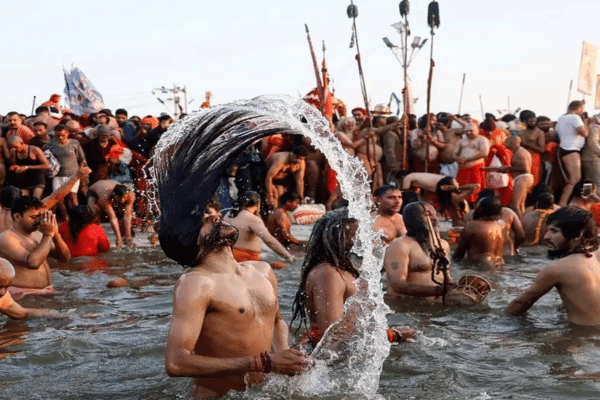11 February. We’re on the 6 am train from New Delhi, bound for the Maha Kumbh Mela at Prayagraj.
The traffic approaching the station was massive, causing a few heart palpitations, but we made it.
The Vande Bharat is very comfortable. India’s newest train, it has luxury reclining seats, well-dressed staff who have served us breakfast. There’s complementary water and newspapers to read, and green fertile landscape out of the clear windows.
We’re in Prayagraj at 12.15 pm. Hugh rush of humanity exiting the station. Stand still and you’ll get carried away with the flow.
A 1.5 km walk with the crowd, dodging the two wheelers, gets us to our vehicles, restricted from parking nearer the station. From here it’s over 2 hours to reach our accommodation – thanks to crowds, traffic, road restrictions, diversions.

Prayagraj is normally 1.5m people strong, and while 250m pilgrims were expected during the Mela period, the actual number will be around 530m.
Must say there’s excellent police security arrangements, though. Large sandbanks on side of the river have all types of accommodation on them – ashram type, boarding houses, hotels.
Tented cities are broken into multiple sectors and different budgets. We are in Sector 25. I am floored by the faith shown by these folks, old and young, travelling in most cases by foot, sleeping rough. No animal sacrifices, no meat, no alcohol.
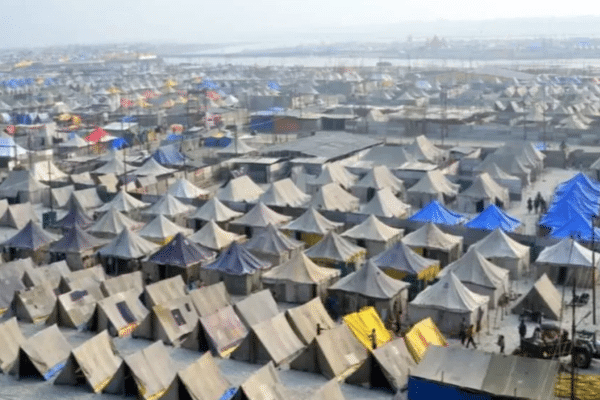
Remember this has been going on for hundreds of years on these specific dates based on the lunar calendar Panchang – a genius planetary interpretation thousands of years old. The West is still not fully aware of the rishis who documented this celestial journey all those years ago.
Touching to see the faith of these millions, making their way here from all over India. I’m certain some of our ancestors travelled by bullock cart and by foot to these events. Sitting at the Sangam, my thoughts are for those millions who preceded us, from all parts of India.
I am awed by the realisation that this is an experience and a journey in the footsteps of our ancestors.
Kumbh Mela is celebrated every 12 years; the Maha Kumbh like this one, or the Great Kumbh, comes around every 144 years.
The Mela site this year is spread across 4000 hectares, houses 160,000 tents, 3000 kitchens and 12 km of ghats (riverfront steps). Temporary police stations have been set up for security and directions, including three anti-human trafficking units.
The economic activity generated over the period will be around the USD $23 billion mark. A vast impact.
Prayagraj has two great rivers of India merging. In the north of the city is the Ganges or Ganga. In the south is the more languid Yamuna. Where they meet is called the Sangam, or Confluence, with the mythological Saraswati being the third river. Hence the name ‘Triveni Sangam’ – a very holy spot for Hindus, Jains Buddhists and Sikhs.
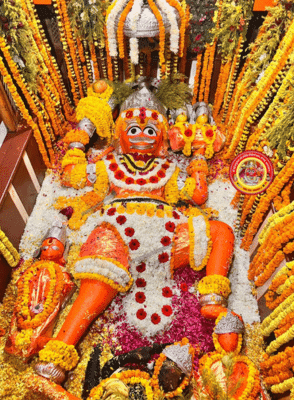
At the land apex of the rivers stands Akbar Fort, built in the 1500s. A couple of temples are within its ramparts, anda Hanuman temple outside. It’s the only temple with Hanuman in supine posture. Each monsoon, the Ganga rises in a tender embrace, caressing Hanuman’s form with her sacred touch. Today there’s a 2-3 hour wait to visit the temple.
North side (i.e. Ganga side) are low hills defining the line of the river. In winter the river is 1 km wide, with an additional 1 km of sandbank. Maha Kumbh
On the south, the sand slopes are over 2 km wide. In the rains the river is almost 5 km wide, covering these sandbanks. Since it is winter now, the sands are compacted.
 Most tent cities are on the south bank. Ours has 200 tents. Lots of NRIs. Our tent F282 is a ‘family’ tent. It has an outer covered area with easy chairs, tables. Main area is 6 m by 6 m. There’s a smaller section for toilet, basin and shower. All separated by blinds. Mosquito nets in the bedrooms.
Most tent cities are on the south bank. Ours has 200 tents. Lots of NRIs. Our tent F282 is a ‘family’ tent. It has an outer covered area with easy chairs, tables. Main area is 6 m by 6 m. There’s a smaller section for toilet, basin and shower. All separated by blinds. Mosquito nets in the bedrooms.
Smaller roads in the tent city have choir runners. Wet areas have floorboards.
All these temporary structures will come down in March or April to be repurposed.
Huge communal dining area. Lots of food choice, all veg of course. Catering at our “Kumbh village” is by Taj Hotels Varanasi.
Warm days. 29 degrees daytime, and cooler at around 7 to 11 degrees at night, so not bad. Windy some days. The winds occasionally pick up the fine river sand and blanket the surrounds, like rough talcum powder.
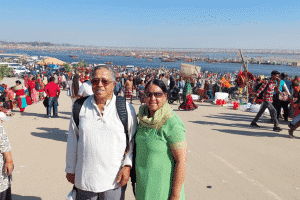
The authorities have constructed three roads running parallel to the river for vehicular traffic. Lots of north-south roads create a grid.
Some 30 temporary pontoons have been built across the rivers – some for vehicles, most for foot traffic. Each bridge is dedicated for one-way foot or vehicle traffic. We were on one yesterday 9 deep, all walking in one direction. Lots of shops, eating places, temporary accommodation, toilet blocks, change blocks along the banks.
Pilgrims are very well behaved. Saw a few wheelchairs as well.
Met an English lady in all-Indian attire. She has a double PhD in Sanskrit and lectures here and in Varanasi.
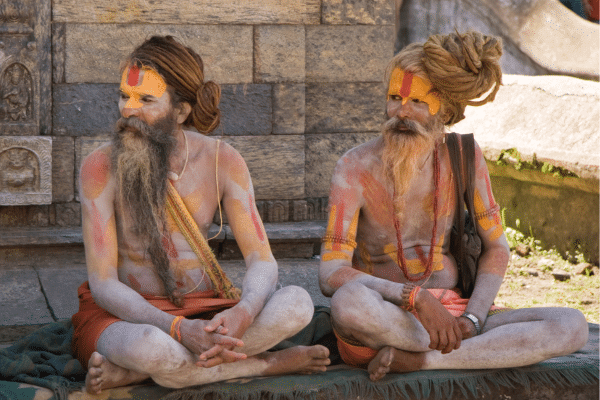
We visit some of the Akhadas. These are monastic structures first developed by Adi Sankracharia 8th CE, as centres for
Sanatana dharma with accommodation for pilgrims, learning centres and wrestling lessons (kushti). These were intended to provide sanctuary to pilgrims and train the body to fight anti Sanatani invaders.
We enter a Naga Akhada called Juna Akhada, one of the earliest to be set up a few hundred years ago.
Saw an MLA (State minister) from Rajasthan. Convoy of vehicles under police escort and hangers-on (chamchas). The material worldly visiting the spiritual wealthy – a contrast only seen in India. Maha Kumbh
Naga babas are the ash-smeared ascetics, with long matted hair and no or minimal clothes. Yes, most carry mobiles now. These ascetics live secluded lives, in the forests, Himalayas etc, having renounced their families and possessions. Some are very learned. They are partial to hashish, often hiding their dilated pupils under dark glasses. They are having long days of praying and blessing a multitude of pilgrims. (To receive blessings, you go into their covered area, give a pranam, donate some money, and get thwacked by peacock feathered wands!) Talk to them and you’ll learn they have a good sense of humour. Some of them tell us they’re going to Varanasi for Shivratri on 26 Feb. They’ll go on foot, or get lifts. Tough ascetics with a very old practice following the Shaivite faith.

On any given Maha Kumbh day, 2-8 million pilgrims take a holy dip at Sangam. We certainly had to have a dip or two. A boat takes us close to the actual Sangam. I wade in: the water looks quite clean, except for the flower and coconut offerings around the shallow sections. I take a full dip, offering prayers facing the sun. Then I venture into the actual Triveni with Ganga in full flow and the more languid Yamuna meeting it. Yes, you can spot the different colours of the two rivers. I sit in the water on the sandbar underneath and gaze at humanity washing away their sins, imaginably or otherwise. There is tranquillity in this moment, despite the crowd and the background noise. My thoughts go to my ancestors who would have done the same centuries or decades ago. Timeless yet in the presence.

I am not easily led by religious fervour, but am here out of curiosity. Yet it is hard not to feel something profound with the millions of faithful participating. The artis and chanting can be heard from miles around, like an airport roar. What an experience.
Massive medical camps here, set up by prestigious Indian and overseas medical teams from Germany, Canada and Russia. Saddened by the news today that there was a stampede at New Delhi railway station. The regular train and a special on different platforms meant a rush from one to the other. 18 dead so far.
Yet, considering 530m pilgrims, this is minimal casualty. The State and Central Governments have done an excellent job on the infrastructure, both permanent and temporary for the largest gathering of humanity ever.
Heading back now. Enroute to Prayagraj station, there’s a gridlock. Our only hope is a pillion ride on a two-wheeler, with our luggage on our laps. For those with larger luggage, a second scooter is needed. This will be a two-hour trip, going down gullies (side roads). At the station, it’s foot traffic, in a one-way system. We walk over an hour with our luggage. One spot gets somewhat hairy – a slip or a fall here could cause an avalanche of humanity pile up. Luckily, there’s security around. The platform, again, is overcrowded. Plenty of special trains coming and going to different parts of India. It’s touch and go in the massive mele, with our bags. We get through safely!
Flying back tomorrow, 18 February, to a quiet, deserted town called Sydney, millions of miles from here. Maha Kumbh
Read more: Five…Six…Pick up sticks (and some coloured powders)




